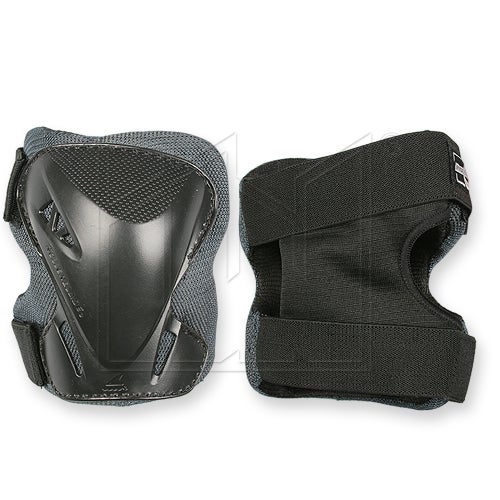Well, most people don't wear pads because they look unattractive. But even the cheap stuff you buy at a big box store usually works for beginners. It's only when you get past the first few basic skills that you realize that these cheap pads can interfere with your skating mobility and body position. Let's look at knee pads today, since when you first learn to skate you'll spend time on your knees.
Knee Pads
There's three main kinds: volleyball pads, inline skating pads, and figure skating pads. I'll go over the pros and cons for each.
 |
| Volleyball Kneepads |
Pros: They work and aren't too confining. I knew a man at Freestyle 4 level who jumped (and fell) in these without problems. I've seen higher level skaters wearing a single pad in practice (I assume to protect an injured knee). Cheap to moderately expensive. Widely available.
Cons: Can't wear them for testing or competition. Some people may feel they interfere with certain elements. If you have large legs, the sleeve may be too restrictive.
 |
| Inline skating kneepad Hard shell |
Inline skating knee pads come in a bewildering variety of designs and levels of quality. Hard shell (as in the picture to the left). Softcap (similar to the volleyball knee pad). Pad integrated into the sleeve, or pad held in place with straps. What distinguishes Inline Skating pads from volleyball pads is that inline pads are generally thicker and designed for someone falling onto concrete.
I have seen these types of pads on many small children in Learn to Skate and a very few adults in Pre-Alpha (Basic 1) type classes. Generally adults give up on these as they are too thick to wear under clothes and must be worn over clothes. Once an adult gets steady on the ice, they seem to go to other protection solutions.
Pros: They work really well. Cheap. Available everywhere.
Cons: Hard to get on. Hard to get to stay in place. Most are designed to be worn over bare legs, not slacks. Bulky and may interfere with moves like cross overs.
 |
| Skating Safe Pad |
For something so thin, they work like magic. I've taken some really hard falls in them and felt nothing. Zip. Nada. Zero. As I said, Magic.
Pros: Can be worn under clothes. Can be worn in testing and competition. Work well. Don't interfere with skating moves.
Cons: OMG. The Price. But my knees are worth it.
There's lots of options for different levels of ability. All of them work. There's lots of price differences so even someone on a budget could afford some kind of knee protection. As you advance you'll probably find yourself needing knee pads less and less as you gain stability. However, at some point you'll have a jump, or a piece of footwork than will land you on your knees and you'll take them up again. Ah, figure skating, the never ending cycle of pain.
I have a skating safe pad for my left hip. Ive never fallen on it, and got it for learning loops, but it is so thin, i wear it all the time. I wish they came in child/adult sizes because i think it is a bit too small. I dont have skinny legs.
ReplyDeleteIf i decide to get other jip +knee +tailbone i will just get the akton gel padding and make my own. But for just one pad, thhat would have been more expensive.
The acton pad homemade gel pads. I'll have to order one and give that a try sometime. Thanks for reminding me.
ReplyDeleteI had rollerblading knee pads for 2 years, really easy to snap over pants. Perfectly happy my DIY gel pads (acton pads), same level of protection without breaking the bank.
ReplyDeletePS: excellent reviews of safety gear!!
Athletes benefit from wearing volleyball Knee pads that provide stability and support for these areas of the body. The knees in particular may take stress from the impact of the knee against the ground when diving. That's why wearing our best volleyball knee pads.
ReplyDelete